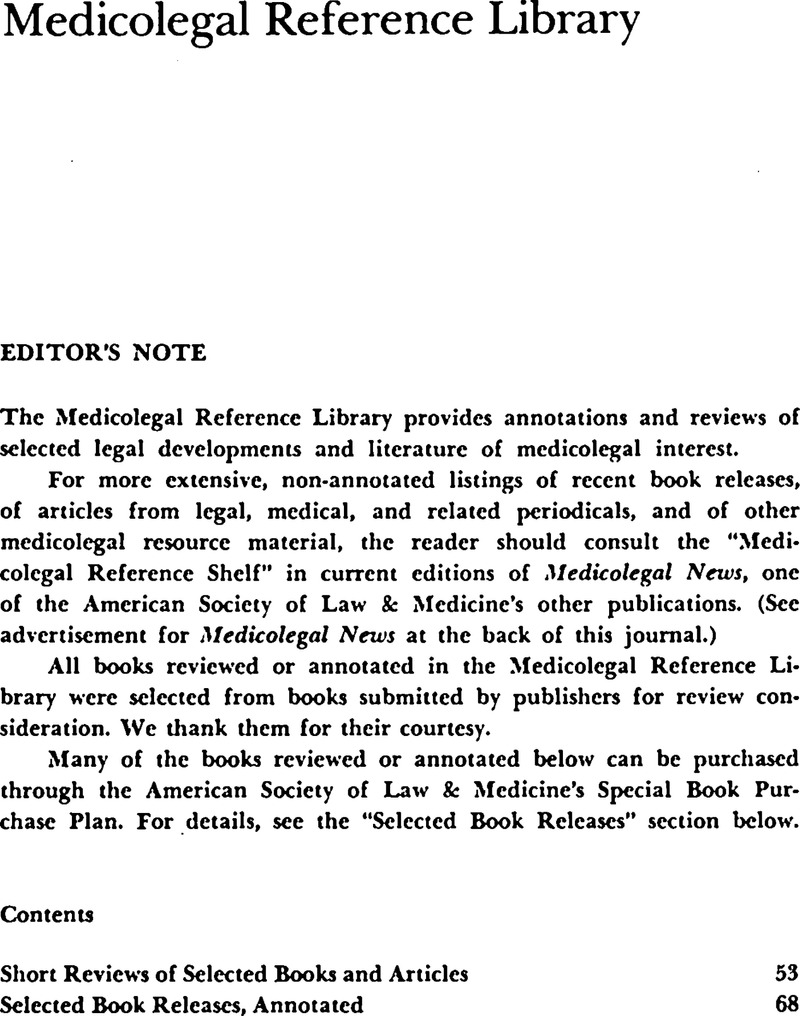No CrossRef data available.
Article contents
Short Reviews of Selected Books and Articles
Published online by Cambridge University Press: 24 February 2021
Abstract

- Type
- Medicolegal Reference Library
- Information
- Copyright
- Copyright © American Society of Law, Medicine and Ethics and Boston University 1980
References
1 Letter to the editor from the Committee on Recombinant DNA Molecules, Assembly of Life Sciences, National Research Council, National Academy of Sciences, 185 SCIENCE 303 (1974).Google Scholar
2 Berg, , Baltimore, , Brenner, , Roblin, & Singer, , Summary Statement of the Asilomar Conference on Recombinant DNA Molecules, 72 PROC. NAT'L ACAD. SCI. USA 1981, 1983 (1975).CrossRefGoogle Scholar
3 “Biological containment” involves the use in experimentation of organisms that cannot survive or replicate outside of the laboratory.
4 NIH Guidelines for Research Involving Recombinant DNA Molecules, 45 Fed. Reg. 6724(1980).
5 The annotated bibliography in RECOMBINANT DNA: SCIENCE, ETHICS, AND POLITICS 337-64 is probably the best available, though it is incomplete and already dated.
6 Swazey, , Sorenson, & Wong, , Risks and Benefits, Rights and Responsibilities: A History of the Recombinant DNA Controversy, 51 So. CAL. L. REV. 1019 (1978).Google Scholar
7 Robertson, , The Scientist's Right to Research: A Constitutional Analysis, 51 So. CAL. L. REV. 1203 (1978).Google Scholar
8 Id. at 1204.
9 Id.
10 Spece, , A Purposive Analysis of Constitutional Standards of Judicial Review and a Practical Assessment of the Constitutionality of Regulating Recombinant DNA Research, 51 So. CAL. L. REV. 1281 (1978).Google Scholar
11 Id. at 1283.
12 Id. at 1351.
13 Id.
14 Friedman, , Health Hazards Associated with Recombinant DNA Technology: Should Congress Impose Liability Without Fault?, 51 So. CAL. L. REV. 1355 (1978).Google Scholar
15 Id. at 1359.
16 Dworkin, Biocatastrophe and the Law: Legal Aspects of Recombinant DNA Research, in THE RECOMBINANT DNA DEBATE 219 (D. Jackson & S. Stich eds. 1979).
17 Michael, Who Decides Who Decides: Some Dilemmas and Other Hopes, id. at 261.
18 Emerson, The Constitution and Regulation of Research, in REGULATION OF SCIENTIFIC INQUIRY: SOCIETAL CONCERNS WITH RESEARCH 129, 132 (K. Wulff ed. 1979).
19 Lappé, & Martin, , The Place of the Public in the Conduct of Science, 51 So. CAL. L. REV. 1535 (1978).Google Scholar
20 Buckley v. Valco, 424 U.S. 1 (1976).
21 Emerson, supra note 18.
22 Id. at 133.
23 Application of this principle would prevent the U.S. government from suppressing the dissemination of information about nuclear explosives, as it recently attempted to do in United States v. Progressive, 467 F. Supp. 990 (D. Wis. 1979).
24 This case is presented in “Please Let Me Die,” a videotape prepared by the Department of Psychiatry, University of Texas Medical Branch, at Galveston.
25 See Lake v. Cameron, 364 F.2d 657 (D.C. Cir. 1966), and the material in J. KATZ, J. GOLDSTEIN & A. DERSHOWITZ, PSYCHOANALYSIS, PSYCHIATRY AND LAW 552-54 (1967).
26 BURT, TAKING CARE OF STRANGERS 118-19 (1979).
27 Id. at 129.
28 Id. at 132.
29 Id. at 140.
30 See J.-P. SARTRE, BEING AND NOTHINGNESS (1956). See also W. KAUFMANN, WITHOUT GUILT AND JUSTICE: FROM DECIDOPHOBIA TO AUTONOMY (1973).


